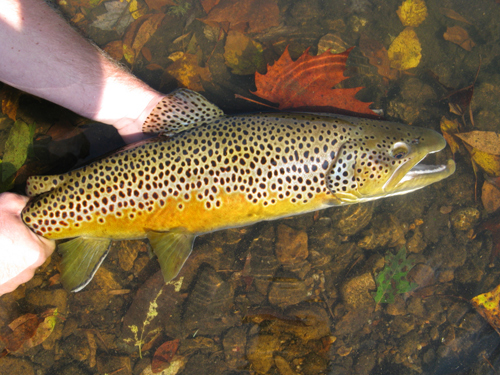BY Lee McClellan
FRANKFORT, Ky. – The dog days of summer settled over Kentucky in the last week, bringing the hottest temperatures of the year. The summer heat in July and August make fishing reservoirs a tough prospect.
Even bluegill get grumpy in the larger lakes at this time of year, much less largemouth bass.
“We are getting to the time of year of the maximum production for baitfish, such as shad, in our reservoirs,” said Ryan Oster, fisheries program coordinator for the Kentucky Department of Fish and Wildlife Resources. “Bass and other predator fish don’t have to search hard for food. The bigger lakes are full of 2- to 3-inch shad; a perfect bite-sized meal for them. They shouldn’t be as hungry on our larger lakes.”

Anglers have options now that reservoir fishing is tough during the day. Oster recommends flowing waters such as creeks and tailwaters below the major reservoirs for fishing during the dog days.
Wade fishing a stream for smallmouth bass is a productive and refreshing way to spend a scorching July or August afternoon. Wading a stream boils fishing down to the essentials; you must carry all of your lures and tackle. Wading harkens back to youthful fishing adventures with older relatives when all you had was one spin cast outfit and a small tackle box.
Streams usually flow low and gentle this time of year, making for easy wading. However, the best fishing of the year is a water rise that follows a soaking rain. Not a flood or water that looks like flowing mud, but a gentle rise that slightly stains the water. Smallmouth bass move to flowing shoals when creeks rise in late summer and hit 4-inch black finesse worms with abandon. They also crush dark brown creature baits that imitate crayfish.
When streams flow at normal levels in July and August, downsize your lure selection for stream smallmouth bass. A 3-inch Senko-style soft plastic jerkbait really shines in low, clear late summer water. Those in hues of green or brown with gold, green, blue, silver or red glitter seem to catch more smallmouths now than those with just black flakes or no flakes at all.
Topwater lures work well right now in the first and last hours of the day. Smaller, subtler topwaters such as a floating/diving minnow draw more strikes in late summer than loud, aggressive topwaters such as a buzzbait. The peak of topwater fishing on streams is still on the horizon in September.
Log on to the department’s website at fw.ky.gov and click on the “Recreational Fishing” tab, then the “Stream Fisheries” tab for a list of smallmouth streams in Kentucky. Click on the “Where to Fish” tab for public access spots on these streams.
The Cumberland River below Wolf Creek Dam is another great place to wade in July and August where the water flows cold year round. The completion of repairs on Wolf Creek Dam brought back the normal release schedule that improved the water quality in the Cumberland River for trout.
“When you see the fish in the Cumberland now, they are more robust, healthier and there are many more big fish,” said Ron Brooks, director of fisheries for Kentucky Fish and Wildlife.
Last year, Kentucky Fish and Wildlife stocked 13,000 15- to 17-inch quick growing, sterile rainbow trout. “We are starting to see many bigger rainbows from last year’s stockings,” Brooks said.
Earlier this summer, Brooks caught a 24-inch brown trout, followed by 20-inch rainbow trout on consecutive casts while on a wade fishing trip on the Cumberland. “I caught several rainbows over 20 inches,” he said. “It was an incredible day, the best day I’ve ever had.”
Brooks said he overheard a conversation between two anglers through the dense early morning fog that is a summer staple on the Cumberland. One lamented an upcoming trout fishing trip to Montana.
“He said we have more and bigger trout here on the Cumberland tailwater than in Montana,” Brooks said. “When you hear something like that, you know you’ve got something special.”
Trout are holding in deep water under rocks, submerged logs and undercut banks during the day right now in Cumberland River. Brooks had his glory day fly fishing a wet caddis fly, but fly anglers report trout currently prefer midges, prince nymphs and bead-head pheasant tails.
Spinning anglers should work small, suspended jerkbaits in the rainbow trout color over rocks, logs or other trout hiding spots. Small deep-running, crawfish-colored crankbaits fished along submerged rocks, logs and along undercut banks also work well. Brown trout especially like this presentation.
“With all of the air conditions running now, they are generating more electricity with more turbines running at the dam,” Brooks said. “Check the generation schedule before you go and be careful wading or boating.”
To check the generation schedule for the day, call 1-606-678-8697 or log on to the Nashville District of the U.S. Army Corps of Engineer’s homepage at www.lrn.usace.army.mil/ and click on the “Missions” tab, then the “Recreation” tab.
The Cumberland is not the only tailwater that holds trout. A list of stocked tailwaters and the monthly trout stocking schedule are under the “Recreational Fishing” tab at fw.ky.gov.
Forget the big lakes during the day in July and August. The flowing waters are best right now.
Author Lee McClellan is a nationally award-winning associate editor for Kentucky Afield magazine, the official publication of the Kentucky Department of Fish and Wildlife Resources. He is a life-long hunter and angler, with a passion for smallmouth bass fishing.
-30-
The Kentucky Department of Fish and Wildlife Resources manages, regulates, enforces and promotes responsible use of all fish and wildlife species, their habitats, public wildlife areas and waterways for the benefit of those resources and for public enjoyment. Kentucky Fish and Wildlife is an agency of the Tourism, Arts and Heritage Cabinet. For more information on the department, visit our website at fw.ky.gov.


Be the first to comment